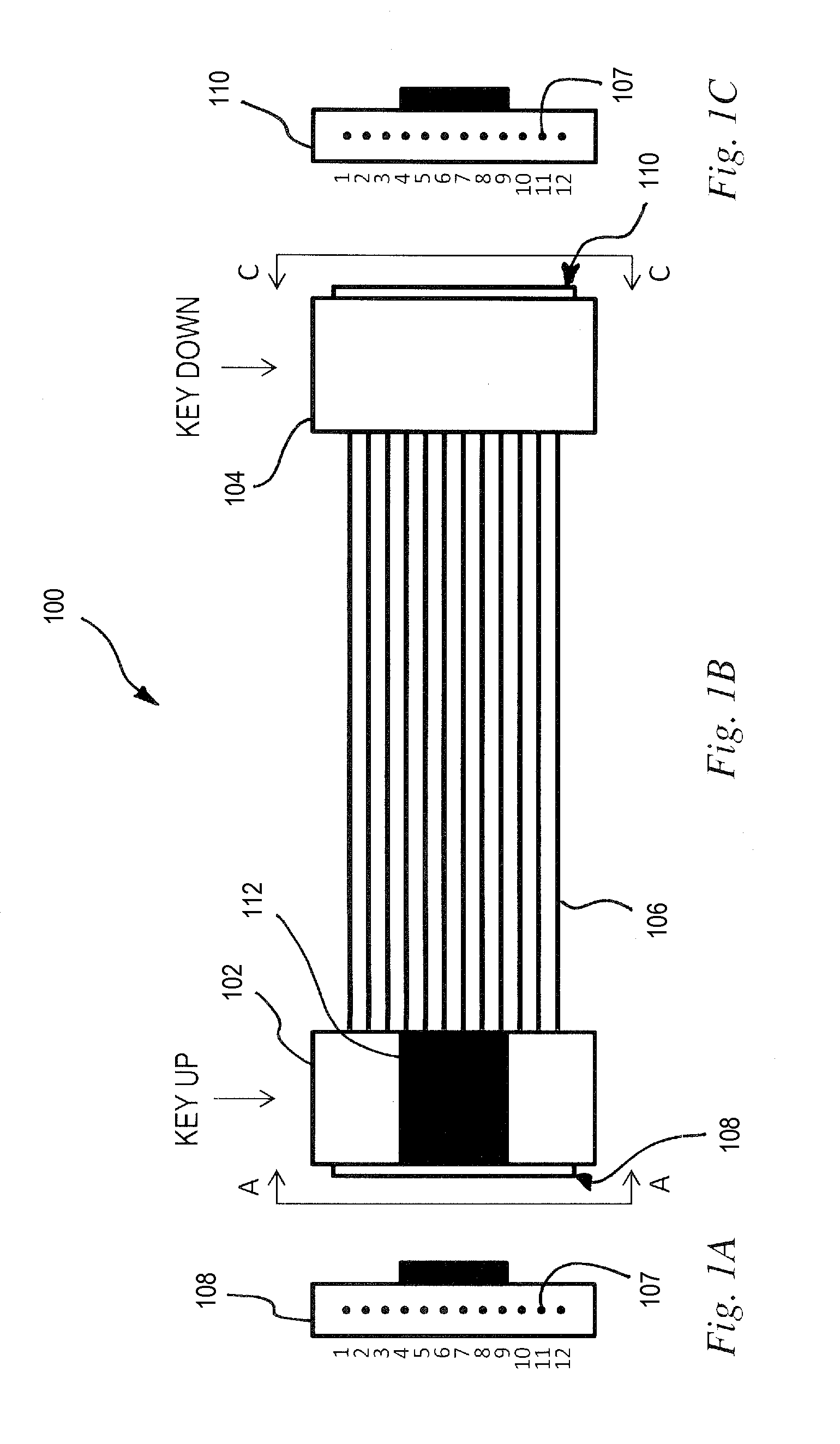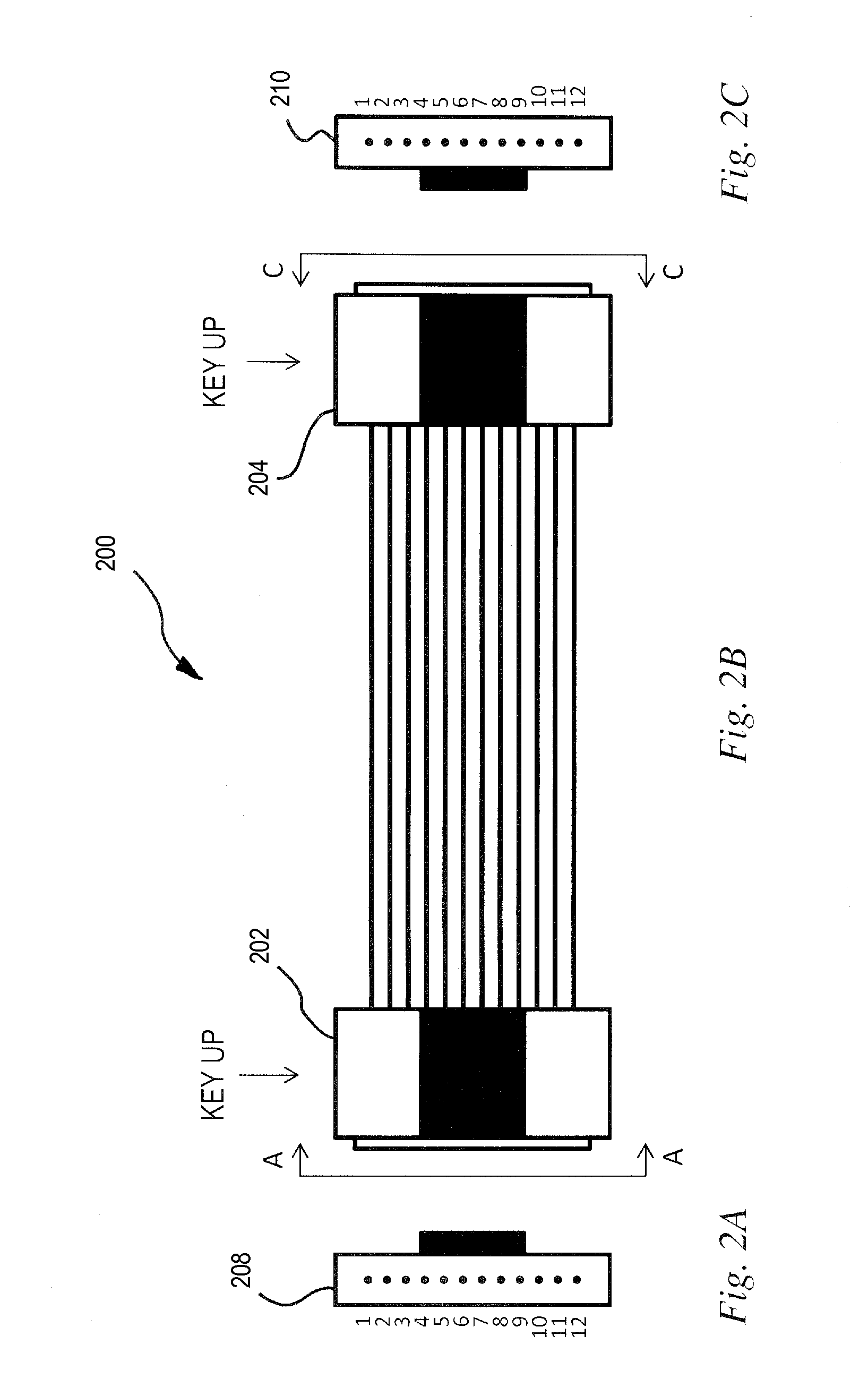Testing fiber arrangement in multi-fiber cables
a multi-fiber array and fiber arrangement technology, applied in the direction of testing fibre optic/optical waveguide devices, transmission, structural/machine measurement, etc., can solve the problems of insufficient olts measurement, poor polarity of multi-fiber array connections, and failure to meet the needs of users, so as to minimize the risk of user connection errors and minimize the wear of connectors
- Summary
- Abstract
- Description
- Claims
- Application Information
AI Technical Summary
Benefits of technology
Problems solved by technology
Method used
Image
Examples
embodiment 550
[0091]Of course, it will be understood that, similarly to the embodiment of FIG. 5A, the input and / or output MPO connectors 554, 556 of the embodiment 550 of FIG. 5B could be replaced by angled-polished physical contact (e.g. FC / APC connectors) and the corresponding event features E1X / E3X be replaced by non-angle polished physical contact connectors (such as FC / PC connectors) inserted along the optical fiber paths 552 to produce the three event features (E1X, E2X and E3X) such that the optical distance L between event feature E1X and event feature E3X is the same for all the signatures.
[0092]It is also noted that if the signature array 500 of FIG. 5A is to be integrated inside test instrument (such as in the test instrument 418), event features E1X could be replaced by the use of a non-angled polished (e.g. FC / PC) at the input MPO connector 504.
[0093]It will be understood that other configurations of signature arrays may be used instead of the signature arrays 500, 550 of FIGS. 5A a...
first embodiment
[0100]FIG. 6A schematically illustrates a loopback device 600 and the corresponding test configuration comprising the signature array 408, the launch cable 410, the cable link under test 402, the receive cable 412 (see FIG. 4) and the loopback device 600. The combination of the signature array 408, the launch cable 410, the cable link under test 402 and the receive cable 412 defines a plurality (in this case 1×12) of optical fiber links 416 on which OTDR acquisitions are to be undertaken using the OTDR system 400 of FIG. 4. The loopback device 600 may be employed for example with the signature array 500 of FIG. 5A for testing a fiber arrangement of the cable link under test 402.
[0101]The loopback device 600 comprises an input MPO connector 602 and six loops 604 of optical fiber that each couple one port of the input MPO connector 602 to another. The length of the six loops are typically similar to that of launch and receive cables (i.e. about 10 to 25 m for testing “premises” optica...
second embodiment
[0107]FIG. 7A schematically illustrates a loopback device 700 and the corresponding test configuration comprising the signature array 408, the launch cable 410, the cable link under test 402, the receive cable 412 (see FIG. 4) and the loopback device 700. In this embodiment, port 1 is coupled back to port 12, port 2 is coupled back to port 3, port 4 is coupled back to port 11, port 5 is coupled back to port 8, port 6 is coupled back to port 9 and port 7 is coupled back to port 10, as shown in Table 4. In this embodiment, the optical fiber loops 604 are also of equal length.
TABLE 4Loopback configuration of loopback device 700 of FIG. 7A112233241158697108596107114121
[0108]The plurality of optical fiber ports of the input MPO connector 702 of the loopback device 700 has alternating even- and odd-numbered optical fiber ports (corresponding to the alternating Rx and Tx polarities in the case of a duplex multi-fiber array configuration). In the embodiment of FIG. 7A, each optical fiber lo...
PUM
 Login to View More
Login to View More Abstract
Description
Claims
Application Information
 Login to View More
Login to View More - R&D
- Intellectual Property
- Life Sciences
- Materials
- Tech Scout
- Unparalleled Data Quality
- Higher Quality Content
- 60% Fewer Hallucinations
Browse by: Latest US Patents, China's latest patents, Technical Efficacy Thesaurus, Application Domain, Technology Topic, Popular Technical Reports.
© 2025 PatSnap. All rights reserved.Legal|Privacy policy|Modern Slavery Act Transparency Statement|Sitemap|About US| Contact US: help@patsnap.com



